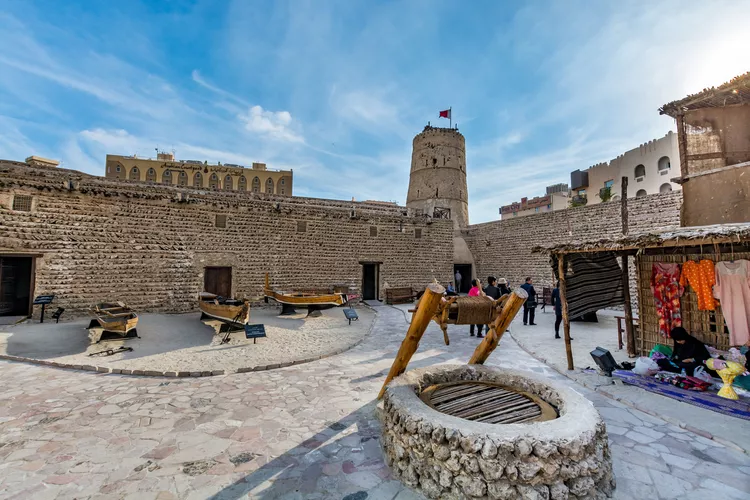Discover Dubai Museum: A Journey Through History
At first glance, you could be forgiven for thinking Dubai is all neck-craning skyscrapers and multi-million-dollar yachts. However, beyond the shiny facade of this ultra-modern emirate lies the bustle and rugged beauty of Old Dubai. At its heart is the Dubai Museum, housed in the historic Al Fahidi Fort. An essential stop for those keen to delve beneath the surface of this Middle East metropolis, Dubai Museum offers a captivating snapshot into the heritage and culture of this fascinating destination.
The History of Al Fahidi Fort
Believed to be the oldest existing building in the city, Al Fahidi Fort was constructed in 1787 at the southern end of Dubai Creek. Over the past 230 years, this coral-and-mortar fort has served various purposes, including a royal palace, fortress, arsenal, and prison. It was transformed into a museum in 1971 by the ruler of Dubai, Sheikh Rashid bin Saeed Al Maktoum, with an additional underground museum added in 1995.
What’s on Show
The historical journey begins prior to entering the museum, as visitors encounter a traditional wooden dhow (fishing boat) and antique cannons mounted near the entrance. Inside the fort, the Dubai Museum is organized into a series of halls surrounding a central courtyard. A spiral staircase leads to the underground galleries, which feature old maps and videos depicting the rapid transformation of Dubai.
Before the discovery of oil in the 1960s, Dubai was a sleepy coastal village surrounded by the desert and the Arabian Gulf. Pearl diving, date farming, and the herding of goats and camels were the main aspects of life for the nomadic Bedouins inhabiting this region. Those pre-oil days are vividly portrayed through full-scale dioramas showcasing scenes from 1950s Dubai, including a souk (marketplace), a mosque, date farms, a Bedouin tent, and a desert oasis. Furthermore, audio tracks and video installations enrich the atmosphere, filling the galleries with the sounds of craftsmen and traders.
The astronomy and natural phenomena wing provides insight into how the Bedouins navigated using the stars, while the marine wing highlights the city’s seafaring heritage. To explore deeper historical roots, visitors can view tombs and a skeleton excavated from the Al Qusais Archaeological Site, an ancient Bronze Age settlement located 7.5 miles (12 kilometers) east of Dubai. Additionally, a folklore wing recounts classic tales from the region, alongside a monuments wing showcasing pottery, weapons, art, and antiquities from trading partners in Africa and Asia.
Getting There
The most affordable way to reach the Dubai Museum is via public transport. You can take the metro or bus to Al Ghubaiba or Al Fahidi stations and then enjoy a 10-minute walk to the museum. If you begin your day at either the Gold Souk or Spice Souk on the north side of Dubai Creek, you can catch an abra (small wooden boat) across the water for just 1 dirham (approximately 30 cents). Afterward, stroll through the Textile Souk to reach the museum. Taxis are readily available, and there is a limited number of parking spaces at the museum if you choose to drive.
Need to Know
The Dubai Museum operates from 8:30 a.m. to 8:30 p.m. from Saturday to Thursday, and from 2:30 p.m. to 8:30 p.m. on Fridays. Entry costs 3 dirhams (about US 80 cents) for adults and 1 dirham for children aged 6 and under. It is advisable to allow one to two hours for your visit.
What to Do Nearby
Situated in the heart of Dubai’s most intriguing neighborhood, you may wish to allow extra time to explore the Al Fahidi Historical District, also known as Al Bastakiya. Timing your visit to coincide with a Cultural Meal at the Sheikh Mohammed Centre for Cultural Understanding can be a rewarding experience. These communal breakfasts and lunches allow you to share a traditional Emirati banquet with locals while asking questions and discovering more about the UAE lifestyle.
Moreover, behind the Cultural Centre, a maze of alleyways showcases artisans selling textiles, calligraphy, and enamelware. Don’t miss the stunning XVA, which houses a gallery, boutique hotel, and a chic courtyard café where you can enjoy refreshing frozen mint lemonade and delicious Arabic vegetarian cuisine.
Alternatively, you can visit the Arabian Tea House Café near the Al Fahidi roundabout, where you can dine under draped fabrics in the atmospheric courtyard. Enjoy sweet shay (tea) alongside a selection of dips, salads, and grilled meats served with freshly baked Arabic bread.





